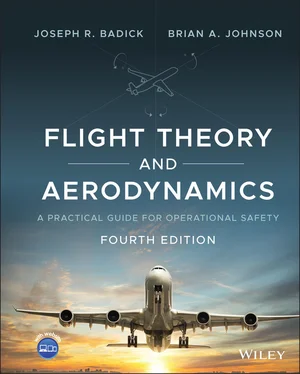Joseph R. Badick - Flight Theory and Aerodynamics
Здесь есть возможность читать онлайн «Joseph R. Badick - Flight Theory and Aerodynamics» — ознакомительный отрывок электронной книги совершенно бесплатно, а после прочтения отрывка купить полную версию. В некоторых случаях можно слушать аудио, скачать через торрент в формате fb2 и присутствует краткое содержание. Жанр: unrecognised, на английском языке. Описание произведения, (предисловие) а так же отзывы посетителей доступны на портале библиотеки ЛибКат.
- Название:Flight Theory and Aerodynamics
- Автор:
- Жанр:
- Год:неизвестен
- ISBN:нет данных
- Рейтинг книги:4 / 5. Голосов: 1
-
Избранное:Добавить в избранное
- Отзывы:
-
Ваша оценка:
- 80
- 1
- 2
- 3
- 4
- 5
Flight Theory and Aerodynamics: краткое содержание, описание и аннотация
Предлагаем к чтению аннотацию, описание, краткое содержание или предисловие (зависит от того, что написал сам автор книги «Flight Theory and Aerodynamics»). Если вы не нашли необходимую информацию о книге — напишите в комментариях, мы постараемся отыскать её.
AERODYNAMICS
GET A PILOT’S PERSPECTIVE ON FLIGHT AERODYNAMICS FROM THE MOST UP-TO-DATE EDITION OF A CLASSIC TEXT Flight Theory and Aerodynamics
Flight Theory and Aerodynamics
Flight Theory and Aerodynamics
Flight Theory and Aerodynamics — читать онлайн ознакомительный отрывок
Ниже представлен текст книги, разбитый по страницам. Система сохранения места последней прочитанной страницы, позволяет с удобством читать онлайн бесплатно книгу «Flight Theory and Aerodynamics», без необходимости каждый раз заново искать на чём Вы остановились. Поставьте закладку, и сможете в любой момент перейти на страницу, на которой закончили чтение.
Интервал:
Закладка:
ICAO STANDARD ATMOSPHERE
To provide a basis for comparing aircraft performance at different parts of the world and under varying atmospheric conditions, the performance data must be reduced to a set of standard conditions. These are defined by the International Civil Aviation Organization (ICAO) and are compiled in a standard atmosphere table. An abbreviated table is shown here as Table 2.1. Columns in the table show standard day density, density ratio, pressure, pressure ratio, temperature, temperature ratio, and speed of sound at various altitudes.
Table 2.1Standard atmosphere table
| Altitude (ft) | Density ratio, σ |  |
Pressure ratio, δ | Temperature (°F) | Temperature ratio, θ | Speed of sound (kts.) | Kinematic viscosity, v (ft 2/s) |
|---|---|---|---|---|---|---|---|
| 0 | 1.0000 | 1.0000 | 1.0000 | 59.00 | 1.0000 | 661.7 | 0.000 158 |
| 1 000 | 0.9711 | 0.9854 | 0.9644 | 55.43 | 0.9931 | 659.5 | 0.000 161 |
| 2 000 | 0.9428 | 0.9710 | 0.9298 | 51.87 | 0.9862 | 657.2 | 0.000 165 |
| 3 000 | 0.9151 | 0.9566 | 0.8962 | 48.30 | 0.9794 | 654.9 | 0.000 169 |
| 4 000 | 0.8881 | 0.9424 | 0.8637 | 44.74 | 0.9725 | 652.6 | 0.000 174 |
| 5 000 | 0.8617 | 0.9283 | 0.8320 | 41.17 | 0.9656 | 650.3 | 0.000 178 |
| 6 000 | 0.8359 | 0.9143 | 0.8014 | 37.60 | 0.9587 | 647.9 | 0.000 182 |
| 7 000 | 0.8106 | 0.9004 | 0.7716 | 34.04 | 0.9519 | 645.6 | 0.000 187 |
| 8 000 | 0.7860 | 0.8866 | 0.7428 | 30.47 | 0.9450 | 643.3 | 0.000 192 |
| 9 000 | 0.7620 | 0.8729 | 0.7148 | 26.90 | 0.9381 | 640.9 | 0.000 197 |
| 10 000 | 0.7385 | 0.8593 | 0.6877 | 23.34 | 0.9312 | 638.6 | 0.000 202 |
| 15 000 | 0.6292 | 0.7932 | 0.5643 | 5.51 | 0.8969 | 626.7 | 0.000 229 |
| 20 000 | 0.5328 | 0.7299 | 0.4595 | −12.32 | 0.8625 | 614.6 | 0.000 262 |
| 25 000 | 0.4481 | 0.6694 | 0.3711 | −30.15 | 0.8281 | 602.2 | 0.000 302 |
| 30 000 | 0.3741 | 0.6117 | 0.2970 | −47.98 | 0.7937 | 589.5 | 0.000 349 |
| 35 000 | 0.3099 | 0.5567 | 0.2353 | −65.82 | 0.7594 | 576.6 | 0.000 405 |
| 36 089 a | 0.2971 | 0.5450 | 0.2234 | −69.70 | 0.7519 | 573.8 | 0.000 419 |
| 40 000 | 0.2462 | 0.4962 | 0.1851 | −69.70 | 0.7519 | 573.8 | 0.000 506 |
| 45 000 | 0.1936 | 0.4400 | 0.1455 | −69.70 | 0.7519 | 573.8 | 0.000 643 |
| 50 000 | 0.1522 | 0.3002 | 0.1145 | −69.70 | 0.7519 | 573.8 | 0.000 818 |
aThe tropopause.
ALTITUDE MEASUREMENT
When a pilot uses the term altitude, the reference is usually to altitude above sea level as read on the altimeter, but it is important that the distinction is made to understand what types of altitude exist. When meteorologists refer to the height of the cloud layer above an airfield, they are usually referring to the altitude above the field elevation. When air traffic control refers to an altitude at FL180 and above, they are referring to pressure altitude. A flight crew in an aircraft approaching the runway during a low ceiling CAT III instrument approach will need to understand the value of a radar altimeter. Understanding what “altitudes” are important at different periods of flight, and the effect of temperature, pressure, and moisture on those altitudes, is imperative for safe flight.
Indicated Altitude
Indicated altitude is the altitude that is read directly from the altimeter and is uncorrected for any errors. In the United States, below FL180 the altimeter is set to the current altimeter setting of the field you are departing from or arriving to, or is given by air traffic control for the current area you are flying in. In the United States, when flying at or above 18 000 ft, altitude is measured in Flight Levels (e.g. FL180 for 18 000 ft). At FL180, the indicated altitude will be equal to pressure altitude as the altimeter setting is set to 29.92″, standard pressure, or QNE. The altitude at which the crew changes to 29.92 is called the transition altitude (TA). When the crew descends for landing, the altitude at which they return the altimeter setting to local barometric pressure corrected to sea level (QNH) is called the transition level (TL). (Remember it this way: 29.92 is selected at the TA, and the “A” stands for aloft, as in climbing or cruise. When returning to land, the TL is set on descent, and “L” stands for low, or landing.)
When QNE is lower than 29.92, the lowest usable flight level is no longer FL180. The lowest usable FL is obtained from the aeronautical publications. For instance, in the United States, if the pressure in the area of operations is between 29.91 and 29.42″, the lowest usable enroute altitude is FL185. It should also be noted that the TA and TL outside the United States will not always be 18 000. ICAO members set their own values.
Incidentally, QFE is the reference pressure set in the altimeter if the pilot wishes to know the elevation above the airfield. When the aircraft is on the airfield, the altimeter reads zero. QFE is seldom used as it would be of limited value when away from the immediate vicinity of the airfield.
Calibrated Altitude
Calibrated altitude is indicated altitude corrected for instrument and installation errors.
True Altitude
True altitude is the actual altitude above mean sea level and is referenced as mean sea level (MSL). On most aeronautical charts, MSL altitudes are published for man‐made objects such as towers and buildings, as well as for terrain, since this is the altitude closest to the altitude read off the altimeter. An important note is that true altitude will only be the same as indicated altitude when flying in standard conditions, which is very rare. When flying in conditions colder than standard, the altimeter will indicate a higher altitude then you are flying, so true altitude will be lower than indicated altitude. The same dangerous situation can develop when you are flying from a high‐pressure area to a low‐pressure area and the altimeter is not corrected for the local altimeter setting. Your altimeter will interpret the lower pressure as a higher altitude and your true altitude will again be lower than your indicated altitude. From the variations in true altitude versus indicated altitude, the saying was developed “high to low, or hot to cold, look out below.” Of course, this assumes that the altimeter is never reset to local pressure for an entire flight covering a long distance with varying temperatures and pressures.
Absolute Altitude
Absolute altitude is the vertical altitude above the ground (AGL), and can be measured with devices like a radar altimeter. Of course, your absolute altitude is more critical the closer to the ground you are flying; so even when not equipped with a radar altimeter, a pilot should be aware of their AGL altitude. When conducting an instrument approach in inclement weather, knowledge of your AGL altitude is vital to the safe completion of the approach or execution of a missed approach. Your height above airport (HAA), height above touchdown zone (HAT), and decision height (DH) are all AGL altitudes and should be briefed before the approach.
Читать дальшеИнтервал:
Закладка:
Похожие книги на «Flight Theory and Aerodynamics»
Представляем Вашему вниманию похожие книги на «Flight Theory and Aerodynamics» списком для выбора. Мы отобрали схожую по названию и смыслу литературу в надежде предоставить читателям больше вариантов отыскать новые, интересные, ещё непрочитанные произведения.
Обсуждение, отзывы о книге «Flight Theory and Aerodynamics» и просто собственные мнения читателей. Оставьте ваши комментарии, напишите, что Вы думаете о произведении, его смысле или главных героях. Укажите что конкретно понравилось, а что нет, и почему Вы так считаете.












